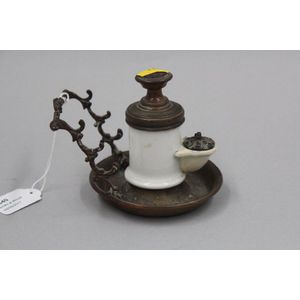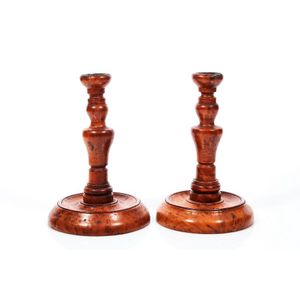Lucie Rie Manganese Glazed Coffee Set
You must be a subscriber, and be logged in to view price and dealer details.
Subscribe Now to view actual auction price for this item
When you subscribe, you have the option of setting the currency in which to display prices to $Au, $US, $NZ or Stg.
- Tin Glazed - Tin glazing is a technique used to decorate earthenware, to produce maiolica, faience and delftware. Once the pottery has been fired, it is dipped into a white opaque glaze of oxides of tin and lead which produces a porous white surface, the background for the brightly painted decoration. The surface is then decorated with enamel colours which are absorbed by the glaze, and then fired again, resulting in the decoration fusing into the surface of the object.
- Sgraffito - In ceramics, sgraffito is a scratched or incised decoration through the slip, applied to the body of the object before glazing, to reveal the colour of the body underneath.
- Manganese Glaze - A manganese glaze contains manganese dioxide as a colorant. When fired at high temperatures, the manganese dioxide in the glaze reacts with the clay body to create a range of colors, including brown, black, purple, and deep red.
Manganese glazes have been used to decorate ceramics for thousands of years, and they have been particularly popular in Chinese and Korean pottery. In China, manganese glazes were first used during the Song dynasty (960-1279 AD), and they were later used in the production of Jun ware during the Ming dynasty (1368-1644 AD). In Korea, manganese glazes were used to decorate celadon pottery during the Goryeo dynasty (918-1392 AD).
The glaze can be applied to pottery using a variety of techniques, including brushing, pouring, and spraying. The glaze can be applied alone or in combination with other glazes to create a range of effects, including speckled or mottled surfaces. However these glazes can be difficult to control, as they tend to be very fluid and can easily run or drip during firing. However, this fluidity can also be used to create interesting effects, such as the "hare's fur" pattern that is often seen in Chinese tea bowls.
Manganese glazes are still in use by potters and ceramic artists to create unique and beautiful surfaces on their work.
This item has been included into following indexes:
Visually similar items

Antique French bronze inkstand with white glazed pottery inkpot, 13 cm high

Rare pair of Australian musk candlesticks, Tasmania, c. 1830-1845, turned wood, on circular stepped bases, minor burn marks to tops (2), height 21 cm. Provenance: John Hawkins Antiques, Tasmania. Collection of George and Adisa Pompei, Sydney

Anneke Borren, set of three black-on-black 'whirling dervish' pots, 1987. Tallest 44 cm. Literature: Illustrated page 30 'Anneke Borren - Ceramiste', 2016 [pub in conjunction with Anneke Borren's retrospective exhibition at Rick Rudd's Ceramics Museum, Wha

Eight Royal Worcester for Hardy Brothers coffee cans & saucers,
